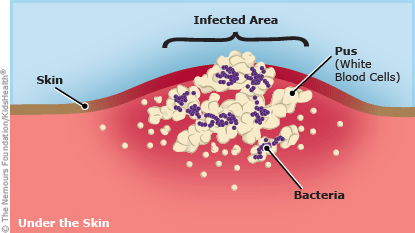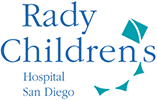MRSA
What Is MRSA?
MRSA stands for methicillin-resistant Staphylococcus aureus, a type of bacteria.
Many people have staph bacteria living on their skin or in their noses without it causing any problems. If staph bacteria get into a person's body through a cut, scrape, or rash, they can cause minor skin infections. Most of these heal on their own if a person keeps the wound clean and bandaged.
MRSA (say: MUR-suh) is different from other staph bacteria because it has become resistant to most of the doctors use to treat staph infections. Methicillin is a type of antibiotic, so these bacteria are called "methicillin-resistant."
What Are the Signs & Symptoms of MRSA?
MRSA skin infections often develop around open sores, like cuts, scrapes, or bites. But they also can affect intact skin. Red, swollen, painful bumps appear that sometimes ooze fluid or pus (called an abscess). Some people also get a fever.

Is MRSA Contagious?
MRSA is contagious. Like all other staph bacteria, it can spread:
- when someone touches a contaminated surface
- from person to person, especially in places where large groups of people are close together (like schools, camps, or college dorms). Often this happens when people with skin infections share personal things like razors, bed linens, towels, or clothing.
- from one area of their body to another, by dirty hands or fingernails
In the past, MRSA mostly affected people in nursing homes or hospitals. It was more likely to be seen in people with weak immune systems. It was also more common in people who had a surgical wound. But now some otherwise healthy people outside of those settings are getting the infection.
Sometimes, people can be "carriers" of MRSA. This means that the bacteria stay on or in their bodies for days, weeks, or even years without causing symptoms. But they can spread it to others. That's why washing hands well and often is so important.
How Is MRSA Diagnosed?
A doctor will examine the affected skin, and sometimes will take a sample of pus or blood. This goes to a lab for testing to find out which bacteria are causing the infection.
How Is MRSA Treated?
Treatment depends on what the infection looks like:
- If there is an abscess, the doctor might make a small cut in the skin over it to let the pus drain out.
- The doctor may prescribe an antibiotic, either to put on the skin or to be taken by mouth (some antibiotics still work for MRSA).
- Someone with a more severe infection might get intravenous (IV) antibiotics in a hospital.
Can MRSA Be Prevented?
These simple steps can help prevent MRSA infections:
- Wash your hands well and often with soap and warm water for at least 20 seconds. Alcohol-based hand sanitizers or wipes are OK if soap and water aren't handy.
- Do not touch or pick at infected areas. Cuts or broken skin should be cleaned and covered with a bandage.
- Don't share razors, towels, uniforms, or other items that come into contact with bare skin.
- If sports equipment must be shared, cover it with a barrier (clothing or a towel) to prevent skin from touching it. The equipment also should be cleaned before each use with a disinfectant that works against MRSA.
When Should I Call the Doctor?
Call the doctor if:
- You have an area of skin that is red, painful, swollen, and/or filled with pus, especially if you also feel feverish or sick.
- Skin infections seem to be passing from one family member to another (or among students in your school) or if two or more family members have skin infections at the same time.
Serious cases of MRSA are still rare. By taking these easy prevention steps, you can help keep it that way!

© 1995- The Nemours Foundation. KidsHealth® is a registered trademark of The Nemours Foundation. All rights reserved.
Images sourced by The Nemours Foundation and Getty Images.
